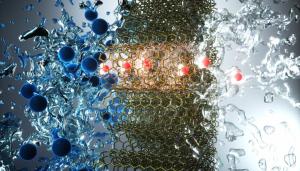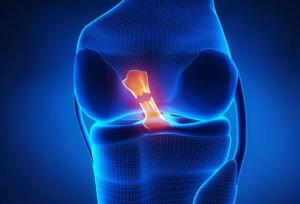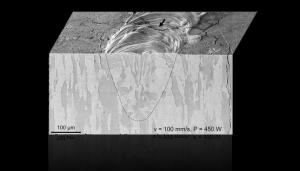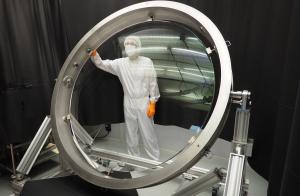LAB REPORT
Science and Technology Making Headlines
Sept. 25, 2020


An artist’s view of small-diameter carbon nanotubes that pass through water molecules (red and white) and reject ions (blue). High permselectivity of small-diameter nanotubes can enable advanced water desalination technologies. llustration concept: A. Noy, T. A. Pham, Y. Li, Z. Li, F. Aydin (LLNL). Illustration by Ella Maru Studios.
Super efficient desalination
Membrane separations have become critical to human existence, with no better example than water purification. As water scarcity becomes more common and communities start running out of cheap available water, they need to supplement their supplies with desalinated water from seawater and brackish water sources.
Lawrence Livermore National Laboratory (LLNL) researchers have created carbon nanotube pores that are so efficient at removing salt from water that they are comparable to commercial desalination membranes. These tiny pores are just 0.8 nanometers (nm) in diameter. In comparison, a human hair is 60,000 nm across.
Biological water channels, also known as aquaporins, provide a blueprint for the structures that could offer increased performance. They have an extremely narrow inner pore that squeezes water down to a single-file configuration that enables extremely high water permeability, with transport rates exceeding 1 billion water molecules per second through each pore.
"Carbon nanotubes represent some of the most promising scaffold structures for artificial water channels because of the low friction of water on their smooth inner surfaces, which mimic the biological water channels," said Alex Noy, LLNL chemist and a lead co-author of the report.


Symptoms of an ACL tear include hearing a loud pop followed by intense pain.
Antibiotics to combat osteo
Tearing an anterior cruciate ligament (ACL) might be an excruciatingly painful injury. Nearly 50 percent of these patients will develop a secondary type of osteoarthritis, deemed post-traumatic osteoarthritis (PTOA).
Researchers from Lawrence Livermore and the UC Davis Medical Center have discovered that therapy with antibiotics before the injury might cut back irritation within the injured joint and slow down the development of PTOA. Specifically, they examined how depletion of the gut biome with antibiotics prior to injury affects the development of osteoarthritis (OA) following a traumatic joint injury.
OA is a painful and debilitating disease characterized by the chronic and progressive degradation of articular cartilage. Inflammation and re-occurring injury can contribute to the progression of PTOA.


Many job applicants looking for jobs during the pandemic have turned to online interviews.
Job seeking in the time of COVID
This spring the pandemic and the economic downturn added a sense of urgency and uncertainty for many job seekers.
Most applicants turned to online interviews and video conferencing. Online interviews reduce travel time, cost and carbon emissions. And they simplify organizational aspects for hosts and candidates. But both sides miss out on informal conversation. For applicants it’s hard to get a sense of lab and office space and a possibly never-visited city without actually being there.
“I do my best work when I connect both at the colleague and colleague-friend level,” said Kristin Beck, who started a new job Sept. 14 as a quantum research scientist at Lawrence Livermore National Laboratory. “Online, that was hard to judge. I’m expecting it will be great, but I still have some trepidation.”
Beck moved from the startup IonQ and initially looked at startup companies in the San Francisco Bay Area, but hiring was frozen for the foreseeable future due to COVID-19. She narrowed her search to Livermore.


By combining simulations with high-speed videos taken during the laser powder-bed fusion process, LLNL scientists were able to visualize the ductile-to-brittle transition in 3D-printed tungsten in real-time, allowing them to observe how microcracks initiated and spread in the metal.
Tungsten is all it’s cracked up to be
Boasting the highest melting and boiling points of all known elements, tungsten has become a popular choice for applications involving extreme temperatures, including lightbulb filaments, arc welding, radiation shielding and more.
However, tungsten's inherent brittleness, and the microcracking that occurs while additively manufacturing (3D printing) with the rare metal, has hampered its widespread adoption.
To characterize how and why these microcracks form, Lawrence Livermore scientists combined thermomechanical simulations with high-speed videos taken during the laser powder-bed fusion (LPBF) metal 3D printing process. Whereas previous research was limited to examining cracks post-build, scientists for the first time were able to visualize the ductile-to-brittle transition (DBT) in tungsten in real-time, allowing them to observe how microcracks initiated and spread as the metal heated and cooled. The team was able to correlate the microcracking phenomenon with variables such as residual stress, strain rate and temperature, and confirm the DBT caused the cracking.


LLNL researchers helped design and build the optical assembly for the telescope camera including one of the world’s largest optical lens ever fabricated shown here. Image courtesy of Rubin Observatory.
A photo op for galaxies
Researchers at the SLAC National Accelerator Laboratory and Lawrence Livermore have successfully tested their digital camera that's capable of taking gigantic 3,200-megapixel photos.
The images are made possible by 189 individual sensors spread over a two-foot-wide focal plane that dwarfs a standard camera's 1.4-inch-wide imaging sensor. Each of the sensors can take 16 megapixel images.
The telescope-camera, once complete, is destined for the Rubin Observatory in Chile, where it will periodically take panoramic images of the complete southern sky for a decade. Its data will feed into the Rubin Observatory Legacy Survey of Space and Time (LSST) – a catalog containing more galaxies than there are living people on Earth.





